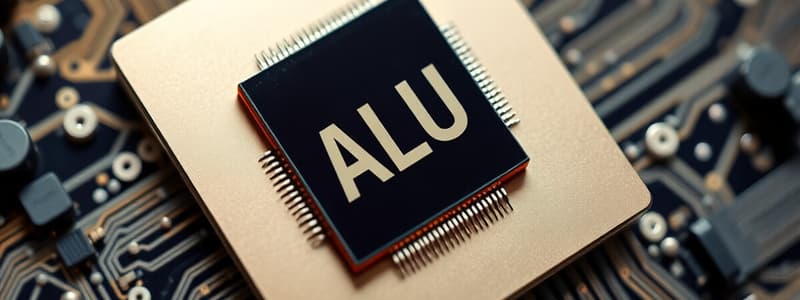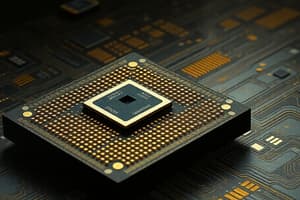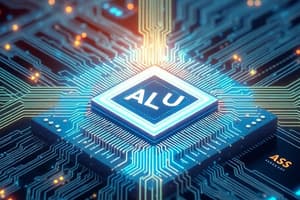Podcast
Questions and Answers
Which component of the CPU is responsible for managing the execution of instructions?
Which component of the CPU is responsible for managing the execution of instructions?
- Control Unit (correct)
- Clock
- Arithmetic and Logic Unit (ALU)
- Memory
What is the primary function of the Arithmetic and Logic Unit (ALU)?
What is the primary function of the Arithmetic and Logic Unit (ALU)?
- Managing data flow between memory and CPU
- Storing temporary data
- Performing calculations and logical operations (correct)
- Controlling the timing of CPU operations
What is the role of the clock within a CPU?
What is the role of the clock within a CPU?
- Controlling the timing and synchronization of operations (correct)
- Managing the allocation of memory
- Storing data temporarily
- Performing complex calculations
Which type of bus is responsible for transferring data between the CPU, memory, and other components?
Which type of bus is responsible for transferring data between the CPU, memory, and other components?
What happens to the data stored in RAM when the computer loses power?
What happens to the data stored in RAM when the computer loses power?
Which of the following is a characteristic of RAM?
Which of the following is a characteristic of RAM?
What is the role of an Address Bus?
What is the role of an Address Bus?
Which of the following describes the function of an interpreter?
Which of the following describes the function of an interpreter?
How does a compiler translate source code?
How does a compiler translate source code?
Which of the following is an example of a high-level programming language that typically uses an interpreter?
Which of the following is an example of a high-level programming language that typically uses an interpreter?
Flashcards
What is the CPU?
What is the CPU?
The central processing unit, a microprocessor.
What is the control unit?
What is the control unit?
It manages work, receives/deciphers instructions, and directs other CPU components.
What is the ALU?
What is the ALU?
The arithmetic and logic unit (ALU) does all the calculations in the CPU.
What does the clock do?
What does the clock do?
Signup and view all the flashcards
What are Buses?
What are Buses?
Signup and view all the flashcards
What is the Data Bus?
What is the Data Bus?
Signup and view all the flashcards
What is the Address Bus?
What is the Address Bus?
Signup and view all the flashcards
What is the Control Bus?
What is the Control Bus?
Signup and view all the flashcards
What is Memory (RAM)?
What is Memory (RAM)?
Signup and view all the flashcards
What is High-Level Code?
What is High-Level Code?
Signup and view all the flashcards
Study Notes
- Computer follows an Input -> Process -> Output sequence, with storage needed during processing.
CPU (Central Processing Unit)
- The CPU is a microprocessor that manages work.
- Key components are the Control Unit, Arithmetic and Logic Unit (ALU), and the Clock.
Control Unit
- Manages operations done by the CPU.
- Receives instructions arriving at the CPU.
- Deciphers the meaning of the instructions.
- Directs other CPU components to execute instructions.
Arithmetic and Logic Unit (ALU)
- Performs all calculations within the CPU.
Clock
- Sends out regular electrical pulses.
- Controls CPU operation timing.
- Ensures instructions execute in sync.
- Measured in Hertz (Hz), indicating cycles per second.
- Memory is joined to CPU by buses
Buses
- The CPU's parts are joined by buses.
- High-speed connections carry data inside the CPU.
Data Bus
- Transfers data between the CPU, memory, and other components.
Address Bus
- Carries memory addresses from the CPU to locate data.
Control Bus
- Sends control signals to coordinate operations.
Memory (RAM)
- Connected to the CPU by buses, storing instructions and data.
- The CPU fetches instructions from memory, executes them, and stores results back.
- Memory contains microscopic electrical circuits that are ON or OFF (binary).
- Data is stored using electrical signals.
- When power is lost, memory content disappears (volatile memory).
- Saving work copies it from memory to storage.
Storage
- Hard disk from computer
- Cloud storage
- Flash memory drive
RAM Characteristics
- Fast and close to the CPU.
- Data is lost when power is off.
Secondary Storage
- Data is safe even when power is off.
- Slower than RAM.
High Level Code
- Programming languages easier for humans to read/write (Python, Java, C++, JavaScript).
- Translated into machine code (binary) for CPU execution.
Source Code
- Original human-readable code written in a high-level programming language
Translation Methods
- Needs translation because cannot be executed directly by a computer
Compiler
- Translates entire source code into machine code before execution.
- Produces a separate executable file (C, C++)
Interpreter
- Translates and executes code line by line at runtime.
- Slower than a compiler but useful for debugging (Python, JavaScript).
Studying That Suits You
Use AI to generate personalized quizzes and flashcards to suit your learning preferences.




